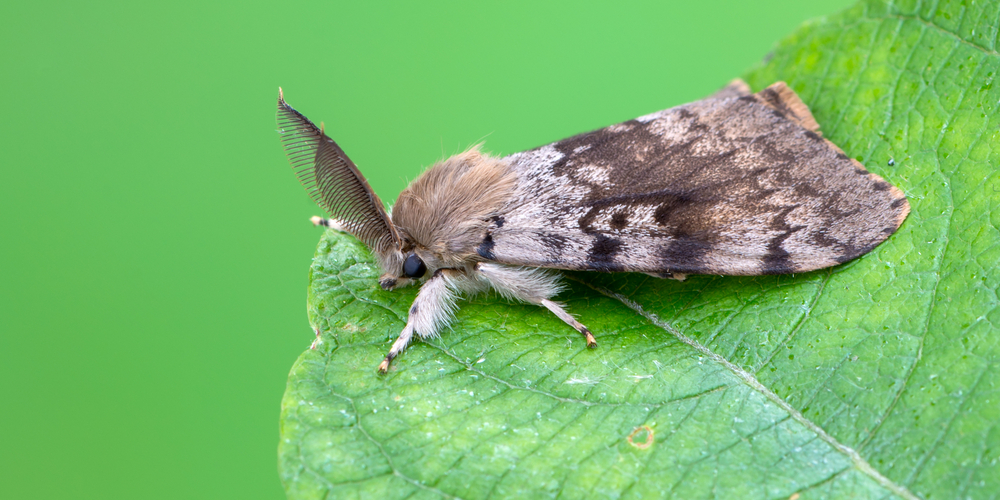Identifying Moth Types
When your favorite sweater comes out with unwanted holes or you find your pantry in disarray, you might be facing a moth invasion. Here’s your quick guide to pinpointing which fluttery culprit has taken up residence in your home.
Common Clothes Moth (Tineola bisselliella):
- Appearance: Small and yellowish-brown with a wingspan of 9 to 16 mm.
- Hangout spots: Wardrobes, drawers, or anywhere you stash your woolens.
Brown House Moth (Hofmannophila pseudospretella):
- Appearance: Larger than the common clothes moth, with a wingspan of 15 to 26 mm, and distinct dark spots on their wings.
- Hangout spots: Wide-ranging – from kitchen to closet, they’re not picky!
Indian Meal Moth (Plodia interpunctella):
- Appearance: Wings have a two-tone look: rusty brown on the ends and pale gray near the body, with a wingspan of 8 to 10 mm.
- Hangout spots: You’ll spot them breaking into your cereal, nuts, or pet food.
Case-Bearing Clothes Moth (Tinea pellionella):
- Appearance: Similar to common clothes moth but carries a “case” around that looks like a tiny cigar.
- Hangout spots: Likes the same fashionable spots as its common cousin.
For more detailed moth insights and identification tips, including images to help you in your moth-hunting exploits, visit Types of House Moths.
Remember, when you’re trying to kick these intruders out, knowing your enemy is half the battle. So grab your detective hat and let’s show these moths they’re not welcome! 🕵️♂️✨
Natural Moth Repellents
When moths try to turn your home into their new favorite hangout spot, it’s time to take action with natural solutions that are safe and pleasantly aromatic.
Essential Oils
Moths aren’t fans of the delightful scents that essential oils offer, making these natural essences your aromatic armor against winged wardrobe assailants.
- Lavender Oil: Not just for relaxation, a few drops of lavender oil on cotton balls can repel moths with its intense fragrance.
- Peppermint Oil: Known for its strong scent, peppermint oil dabbed around closets and drawers works as a moth deterrent.
Herbs and Spices
Your pantry holds powerful allies in your battle against moths, with herbs and spices serving as natural repellents that moths prefer to avoid.
- Bay Leaves: Tuck some bay leaves into your shelves to keep moths at bay with their sharp, strong smell.
- Cedar: Chips or blocks of cedar provide a long-lasting moth-repelling scent that doubles as a décor piece.
These natural repellents need regular refreshing to maintain their effectiveness—but they’ll keep your spaces smelling great as they guard against unwanted guests.
Moth-Proofing Your Home
Getting rid of moths starts with making your home inhospitable to these fabric-loving pests. Your goal is to clean thoroughly and store items properly, so moths can’t settle in.
Cleaning Techniques
- Vacuum Regularly: Hit those corners and closets where moths like to hide. Remember, the cleaner your home, the less attractive it is to moths.
- Wipe Surfaces: Use a solution of dish soap and hot water to clean shelves and drawers, especially in areas where you’ve spotted moths or larvae.
Storage Solutions
- Seal Containers: Store clothes and linens in airtight containers to keep moths at bay. Vacuum-sealed bags are great for seasonal garments.
- Use Moth Repellents: Cedar wood has natural moth-repelling properties; place blocks or rounds of cedar in your closets and drawers to fend off invaders.
Chemical Solutions
When you’re facing a moth invasion, chemical solutions can be a fast-acting option to reclaim your home. Here are some of the most effective chemical agents you can use:
- Mothballs: The old standby, containing either naphthalene or paradichlorobenzene. These are perfect for storage areas but remember:
- Use them in a sealed space to prevent the fumes from escaping.
- Keep them away from living spaces and out of reach of children and pets.
- Moth Sprays: Aerosol insecticides can target moths in flight or on surfaces.
- Look for sprays specifically designed to kill moths.
- Apply according to the instructions, usually with a focus on closets, drawers, and dark corners.
- Insect Growth Regulators (IGRs): These disrupt the growth cycle of moths.
- Apply in areas where moths are likely to breed.
- They don’t kill adult moths but prevent larvae from maturing.
How to Use:
- Read Labels: Always check the product label for usage instructions and safety warnings.
- Ventilate: Keep your area well-ventilated when applying chemical treatments.
- Spot Test: Before going all out, spot test any sprays on fabrics to avoid damage.
- Follow Up: Regularly monitor and reapply as necessary to keep moths at bay.
Professional Pest Control
When your moth situation feels like an epic saga, it’s time to call in the cavalry—that’s right, your friendly professional pest control experts. Donning their superhero capes (okay, maybe just standard uniforms), they come armed with the tools and know-how to rescue your wardrobe and pantry from these persistent pests.
- Assessment: First things first, they’ll inspect your domain, from the deepest closet corners to the tiniest pantry crevices. Finding the source is key, and these pros are like detectives with a flashlight.
- Treatment Plan: Based on their sleuthing, they’ll draft up a battle strategy. This could be anything from chemical treatments—like fumigation—to non-toxic solutions, depending on the severity and your preference.
- Maintenance Tips: They won’t just leave you high and dry! Expect some sage advice on how to keep the moths from staging a comeback.
- Follow-Up: If the problem was as epic as a season finale, they might schedule a return visit to ensure those moths haven’t pulled a cliffhanger on you.
Frequently Asked Questions
Moths in your home can be a real pain, but there are tried and true ways to combat these winged wardrobe wreckers. Let’s dive right into some of the most common questions you have about keeping those pesky moths at bay.
What natural remedies can prevent moths from invading the home?
Your first line of defense against moths is to use natural repellents. Lavender pouches, cedar blocks, or sachets filled with dried rosemary and mint can work wonders in deterring moths from settling in your cozy quarters. Place these in closets, drawers, and any other areas prone to moth activity.
What are the most effective methods to eliminate moths inside the house?
Your go-to strategies should include thorough cleaning and the use of moth traps. Vacuum regularly to remove any moth eggs and larvae, and wipe down surfaces. Set up pheromone traps to catch adult moths and break the breeding cycle.
What could be attracting moths to my living space?
Moths are often drawn to your home by easily accessible food sources and materials they can feed on. Leftover crumbs, spills, and uncovered pantry items, as well as natural fibers like wool and silk in your clothes, are moth magnets. Stay vigilant by keeping your food in sealed containers and your living space clean.
Which techniques are best for protecting clothes from moth damage?
To keep your clothes safe from the jaws of moths:
- Wash them regularly and store them properly.
- Consider using sealable garment bags for storing out-of-season clothing.
- Place moth preventatives like cedar and lavender among your stored clothes as an extra layer of defense.
Can I use vinegar to deter moths, and what is the best approach?
Absolutely, vinegar can help repel moths due to its strong scent.
You can create a cleaning solution by mixing equal parts white vinegar and water. Use this to wipe down your closets and drawers.
Moths dislike the smell, giving you a moth-free wardrobe.
Is there an effective strategy to discourage moths from hanging around outdoor areas?
Keeping moths from loitering around your outdoor living space involves:
- Reducing outdoor lighting at night, which can attract moths.
- Regular maintenance, such as keeping the garden free of overripe fruit and fallen leaves.
- Using screens on windows and doors to prevent them from flying inside.
Last update on 2024-07-26 / Affiliate links / Images from Amazon Product Advertising API




